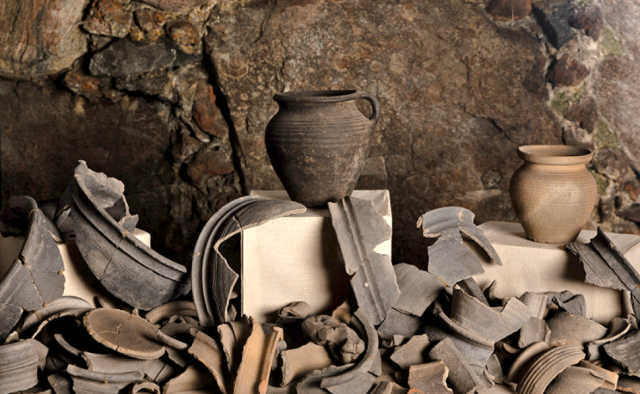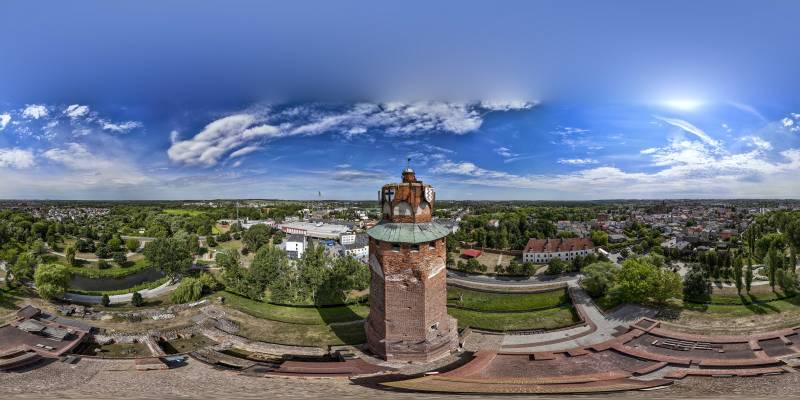The castle was built north of the city, on the right bank of the Drwęca, near a small tributary used to irrigate moats. It was one of the most powerful Teutonic fortresses, the seat of the commandery, and also served as a protection for the river ford and the city founded under Chełmno law in 1298 and 1353. The castle was built on the site of a wooden defensive structure mentioned in 1285. Its construction had 4 stages. The first stage from the beginning of the 14th century to around 1317 was completed with the construction of the perimeter wall, the tower and some of the internal buildings. This was also the time when the construction of the fortifications of the outer bailey took place, which until the completion of the actual castle served as a fortified camp. By 1337, the construction of the convent was completed, then the chapel was consecrated and the first commander, Frierdrich von Sprangenberg, was replaced. In 1387, the so-called New House was built, most likely located on the outer bailey. The last stage of the castle's construction took place in 1415 and is associated with the stay of the Malbork builder Mikołaj Fellenstein. The reconstruction concerned the fortifications. Two low bastions were built, in the western corner of the interwall and in the northern bend of the outer bailey walls. In 1466, the castle was taken over by Polish troops. In 1481, a non-city starosty was established there. In 1550, the castle and the town were consumed by fire. The reconstruction was undertaken by the starosta Rafał Działyński. A new residential house erected at the eastern curtain wall of the outer bailey dates from these years. In 1605, the castle was rebuilt for Anna Wazówna, who died there in 1625. During the Swedish wars, the castle was seriously damaged. The castle wings were demolished in the years 1787-89 and at the beginning of the 19th century. The devastation was stopped by Frederick William IV with a decree from 1842. Before the outbreak of World War II, the ruins were tidied up and research was still underway in 1940. In 1945, the destruction was completed by a fire that destroyed, among other places, the Vasa Palace. In the 1970s and 1980s, archaeological and conservation work was carried out, exposing, securing and reconstructing part of the ruins. Part of the castle was exposed as a permanent ruin, part was used as a museum space.
The castle was built on a square plan, made of brick on a stone foundation. The residential wings, with basements, were equipped with three corner, quadrangular turrets, which in the 17th century received Baroque spires, similar in form to the spires in the castle in Golub. A small dansker ran out towards the river from the southwest. A tower almost 50 m high rose to the north. The tower was hexagonal in the lower part, octagonal in the upper part, topped with an observation terrace and an orthogonal superstructure originally covered with a tented roof. The domed covering is associated with the reconstruction undertaken by Anna Wazówna. The upper storey was decorated with shallow, plastered blind windows, the whole has a zendrówka decoration. The tower was accessible only from the defensive porch running along the upper storeys of the castle wings. The castle gate with a foregate and a drawbridge over the moat adjoined the gate. The main rooms of the convent were located on the second storey in the short north-eastern wing. The chapel of Corpus Christi and the Virgin Mary was placed in the south-eastern wing. Five bays of the chapel were vaulted in a star pattern. The chapel was decorated with polychrome figures of the apostles and a profiled portal. The chapter house was placed in the north-east wing, while the commander's, chaplain's and infirmary chambers were in the south-west wing. The height of the elevation can be read thanks to the preserved remains of the walls by the tower, they were about 17 m. The supports of the guard porch are also impressive. The gable walls of the wings were probably decorated with a stepped outline. The outer bailey, on the plan of a vast quadrangle, was located on the south-east, surrounded by a separate wall with two gates. The fortifications were coupled with the castle fortifications. Another outer bailey could have adjoined the castle complex from the east. (source http://www.polskiezabytki.pl/m/obiekt/929/Brodnica/)



 Places
Places Guides
Guides Map
Map Outdoor games
Outdoor games Trails
Trails Events
Events Mobile app
Mobile app Contact
Contact




